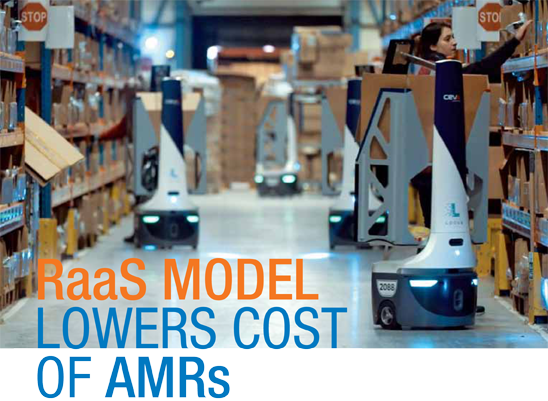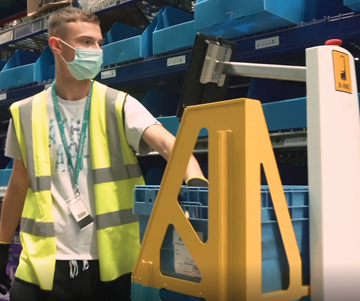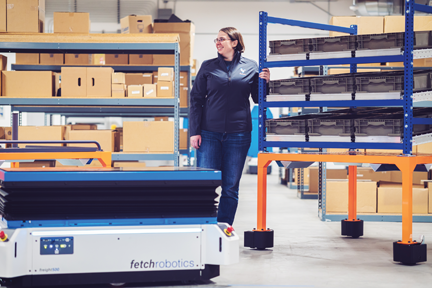Raas Model Lowers Cost of AMRs

by Rich Vurva
Since the start of the pandemic last year, a notable number of companies have begun looking into adding robotics and automation into their fulfillment operations. Some industrial distributors are beginning to realize the benefits of using autonomous mobile robots (AMRs) to improve workflow in warehouses and reduce costs. A new Robots as a Service (Raas) model makes them more affordable than ever. Here are some suggestions from a few of the companies that provide robotic technology appropriate for warehouses.
Vered Tomiak
Director of Marketing Programs
Locus Robotics
 |
| Worker training is as simple as pick, touch, and go using LocusBot’s user-friendly, easy to read, touch pad-based user interface. |
The pandemic has caused a dramatic shift to online, changing not only the way retail consumers shop, but also the B2B industrial segment. Companies that were previously slowly shifting toward a digital warehouse strategy are now rushing toward it. While labor has been a major concern in the past, the pandemic has exacerbated it with lockdowns and social distancing for health safety requirements that impact recruiting and retention, while volumes continue to increase exponentially. The only viable way to cost-effectively mitigate this problem is through automation.
The cost to invest in robotics technology has dramatically lowered in the past few years. For example, Locus offers a Robots as a Service (RaaS) model that allows warehouses to add AMR robotics automation to their existing operation at a reasonable cost while delivering an ROI that is in months vs. years. Because Locus can double the productivity of a worker, warehouses can get more productivity out of their existing workforce within the same footprint.
Our RaaS model gives operators the flexibility they need to meet changing demands: whenever volumes grow due to seasonality or sudden demand spikes, they simply add more bots and reduce them whenever the volumes lower – without extensive reconfiguration or complicated setup needed. Frankly, if operators are not implementing robotics automation now, they risk falling further behind.
Nearly 95 percent of warehouses are not currently automated. The Locus AMR solution delivers intelligent automation that is easy to implement in both existing and new warehouse environments. Our multi-bot solution has helped a wide range of industrial customers gain the flexible automation they need to meet today’s demands
and be positioned for growth in the future.
The Locus solution can be implemented in just four weeks and provides a rich suite of easy to use operational reporting and management tools that enable operators to stay on top of their labor management, product slotting, and more, all in real time.
Jason Walker
CEO and Co-Founder
Waypoint Robotics
 |
| The Kingpin lift & hitch module can both load/unload payloads and connect to a variety of carts for flexible material movement. |
We are hearing from more and more industrial distributors that are experiencing an increase in demand. Their workers, who are the company’s most rare and valuable resource, are spending a lot of time pushing carts or moving parts. These are tasks that workers have told us they hate because it limits their ability to contribute to the company goals, and it’s a waste of their talents.
We see many benefits in deploying mobile robots. Waypoint builds AMRs that are easy to set up and use so there’s immediate value in workers being able to immediately utilize the robots to move materials from point A to B rather than pushing carts across their facility. Because our AMRs can be easily reconfigured, there’s the added benefit of flexibility when workflows need to quickly change on a daily or even hourly basis. These changes are often costly or time consuming when fixed equipment like conveyors are involved. With the dynamic obstacle avoidance and robust safety systems built into our AMRs, workers can confidently employ the robots while staying safe and socially distanced. Wireless autonomous charging enables our robots to move materials 24/7.
Another ROI that is easy to understand, but harder to quantify, is with the workers themselves. As mentioned, Waypoint AMRs are designed for workers to use so they aren’t required to do physically taxing, monotonous or dangerous tasks. Workers using great tools are more engaged in work they are proud of. They have more energy, better quality of life and longer, more productive careers. Companies that give workers great tools more easily attract and retain talent. Plus, distributors get the benefits of automation as well as the loyalty of an empowered workforce.
Waypoint offers omnidirectional autonomous mobile robots to move materials and we also offer various accessories and top modules to automatically load and unload materials. Our Vector AMR can carry loads of up to 600 pounds and MAV3K can carry up to 3,000 pounds. Waypoint AMRs include dispatcher software for easy set up and control. For top modules we have the Kingpin lift & hitch module that can both load/unload payloads and connect to a variety of carts for flexible material movement. We also offer a conveyor deck top module to quickly move materials to or from existing or new conveyors. Our EnZone autonomous wireless charging system enables Waypoint AMRs to maintain their own batteries and charge when needed.
Fergel Glynn
Vice President, Marketing
6 River Systems
As many warehouses are experiencing labor shortages, distributors are increasingly exploring automation solutions to empower their employees and allow them to work more efficiently. Solutions such as collaborative mobile robots allow associates to work smarter, enabling them to get more done in less time while reducing fatigue. The robots work alongside associates to lead pickers through their work zones to help them minimize walking and stay on task. Adding automation solutions into the warehouse to ease manual labor can also increase workplace morale. A less physically demanding job is more attractive to prospects, expanding the potential labor pool. Collaborative robots are quick and easy for both new and existing employees to learn, making training time minimal no matter what their level of experience is. Warehouses that use robotic automation can realize a quick ROI, with a two- to three-time increase in productivity and a reduction in errors.
Purchasing and implementing robotic automation, such as automated mobile robotics (AMRs), into the warehouse, is a very cost efficient option for warehouses and distributors of all sizes. Compared to traditional and more rigid automation options like conveyors, AMRs offer the flexibility to add additional robots to the floor during peak seasons and remove them when demand recedes. Many solution providers even give warehouses the option to rent mobile robots seasonally to assist with volume increases, making it a smaller financial commitment. Often, they can integrate into a site’s existing Warehouse Management System and require little to no new infrastructure, therefore eliminating the added costs of restructuring your warehouse space to accommodate this technology.
Our customer Lockheed Martin achieved ROI in just nine months and saw a 381 percent increase in lines picked per hour achieved in six weeks. Additionally, plumbing wholesaler Legend Valve doubled its pick rates after implementing our solution and significantly increased order accuracy.
6 River Systems offers both hardware and software solutions that support wall-to-wall fulfillment operations. We also have a robust partner ecosystem and collaborate with vendors like Packsize and Accutech to complete other tasks within the warehouse including packing, replenishment and more. Our main warehouse solutions include:
Chuck: 6 River Systems’ automated mobile robot, Chuck, leads associates through their work zones to help them minimize walking, stay on task and work more efficiently. We have improved Chuck’s usability with globally recognized lighting, images, and prompts to accelerate training and direct associates through their tasks. State-of-the-art sensors help it navigate in any warehouse without new infrastructure. The solution can be used on all types of warehouse floors, including rack-supported mezzanines.
Last year, we increased Chuck’s capacity, holding up to six levels for a total of 43.5 ft² / 4.0 m² of workspace, over three times more than the other providers, it handles a broad range of SKUs and a payload of up to 200 lbs. / 90.7 kg. The real power behind Chuck is our software. AI and machine learning allow for dynamic zoning that updates associates’ working areas in real time depending on the profile of work that needs to be completed. To provide more visibility into operations and increase efficiency, we developed The Bridge, an overarching tool that connects the data from what’s happening on the ground in a physical warehouse operation to an intuitive cloud-based control center.
Mobile Sort: Mobile Sort is designed to help operators rise to meet peak demands and challenges by enabling warehouse operators to intelligently generate and fulfill batched orders. Mobile Sort stations consist of smart kiosks and mobile put-to-light walls with validation sensors that work with our software and Chuck.
 |
| CartConnect robots and FetchCarts seamlessly automate the vast myriad of cart workflows that operate within warehouses and manufacturing environments. |
Melonee Wise
CEO
Fetch Robotics
Many industrial distributors are experiencing an increasing demand for their products while simultaneously facing labor shortages, a situation that was exacerbated by COVID-19. Similarly, we’ve seen a growing reliance on automation as companies adapt to changing consumer behavior as e-commerce has grown to unprecedented levels during the pandemic. With increased demands on facilities and less manpower to tackle everyday tasks, we’re seeing industrial distributors turn to robots, including autonomous mobile robots (AMRs), to supplement their existing workforces and alleviate menial and physically demanding tasks. With the help of AMRs, workers can focus on high-value tasks while avoiding injuries in a fast-paced, high-stress environment.
While robotics technology has historically demanded large up-front investments, new payment models, such as Robots-as-a-Service, are making investments more
manageable than ever. RaaS makes the deployment of robots fast, cost-effective, less risky and a scalable way to harness the power of robotics and automation within warehouses and distribution centers without the large capital investments and often third-party expertise required to build those capabilities from the ground up.
Traditional fixed automation has a long lead-time due to extensive engineering, control, power and installation requirements. It requires a large allocation of space and also needs tear-down and re-configuration when processes change. For example, with on-demand automation powered by a RaaS business model, an organization can create a virtual conveyor for material transport or set up autonomous data collection in just hours using a combination of cloud-based software and AMRs. This offers the potential to completely transform a company’s entire warehouse logistics operations.
We have a number of industrial distributors of all sizes as customers. Some of these only distribute products to businesses while others ship to both businesses and consumers from the same facilities. Since most distributors have a broad product offering of different shapes, sizes and weights, Fetch’s broad portfolio of AMRs helps them have a single AMR solution for all their products.
Some common use cases are transporting products from an AutoStore system or equivalent solutions to sortation or shipping. This can be done autonomously using our RollerTop AMR or by using our CartConnect AMRs.
We also have an industrial distribution customer that has reclaimed 13 percent of its warehouse space back by removing conveyors and replacing with our RollerTop AMRs that will then autonomously transport and induct into sortation or shipping.
This article originally appeared in the March/April 2021 issue of Industrial Supply magazine. Copyright 2021, Direct Business Media.













